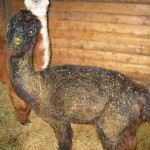If you’re new to caring for livestock you soon realize that you need a small arsenal of shovels, rakes and forks to pick through all the different medium your fuzzy friends poop in or on. It seems rather odd for me to be writing a post about poop detail but the truth is it’s an art. Yes I said art. A seasoned ranch hand can wield a fork with the grace of swordsmen. Professionals can toss just one horse apple from a fork at a time across a 12’ stall into a muck bucket or the whole pitch without missing their mark. Yes, I call mucking an art.
I still haven’t found the perfect alpaca fork yet but here is what I have in my barn and their use.
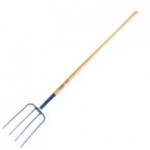
Pitch Fork:
Pitch forks are a time tested piece of equipment and every farm should have one. They have wood handles and strong metal tines. I personally like 4 or 5 tines to my forks so less stuff falls through them. Pitch forks are used for heavy wet hay/straw that needs to be removed. These are great for anyone who uses straw for bedding. Personally I can’t stand straw bedding and the work it takes to keep a straw stall so my pitch forks are used to remove hay waste or when I need to pick into mud. Plastic and shoves do not do mud well.
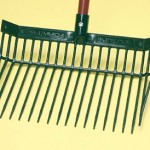
Classic Stall Fork:
Typical stall forks are usually wood handled with molded plastic ends with 17-18 tines and come in many colors. These are my most favorite forks and my first choice for most applications. The fork is light weight, sturdy, holds on to waste easily while allowing you to sift out the bedding or dirt from the fork. This fork is the best for horses in sawdust or pine shaving bedding. Alpaca beans are too small and fall right through the fork unfortunately. I do use the fork to pick up pee areas for the alpacas since the sawdust clumps together nicely. This stall fork is also great to use as a rake when adding new bedding to a stall. Using a traditional rake is slow because it’s not strong enough to handle moving high volume sawdust.
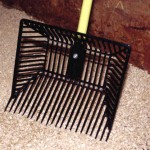
Fine-Tines Stall Fork:
Much like the traditional stall fork the Fine-Tines fork advertises 30 tines instead of 17-18 allowing smaller waste to be kept into the fork while still sifting the clean bedding out. It’s an expensive fork $30! I contacted the company and inquired about its use on alpaca beans. They said they had alpaca owners buy them but have never received feedback on their effectiveness. Well here’s my review…. Don’t buy this fork! Sorry Fine-Tines folks but the fork is very heavy, I hate the big basket on the end, it only traps 30% of the alpaca beans in the fork and its weird shape and bulkiness doesn’t allow it to bulldoze through bedding as easily as the traditional stall fork. I was very disappointed in my purchase L
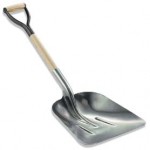
Shovel/Scoop:
Wide, flat bottom, coal shovel is my choice. I use the shovel just as much as my stall fork. It’s the only thing I’ve found to scoop up alpaca beans and great for stripping down stalls. There are a ton of things the trusty shovel can do and it’s one thing that my hubby used to run off with but now he has his own.
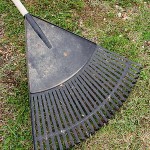
Yard Rake:
Your everyday yard rake be it plastic or metal, your choice. I prefer plastic; tines tend to keep their shape longer. Alpaca beans are easily raked up into scoop-able piles, tidies loose hay/straw into piles and makes a great butt scratcher for your horse. Yes, a butt scratcher; my horses just love to get a good butt itch in with the rake.
I still haven’t found a fork that works to sift out alpaca beans from sawdust. I’ll keep you updated once I find or make a fork for this application.
To make your chores quicker and easier on you and your bedding budget I highly recommend a 4-6” base of sand or stone dust covered by rubber stall mats. Interlocking mats are best but if your base is thick enough, standard 4×6 mats from tractor supply work great too. If you don’t get your base thick enough and it heaves with the freeze/thaw cycle then non interlocking mats can buckle. Your trusty shovel easily will glide over mats without catching on anything or digging up your valuable base material.
Happy Mucking!
